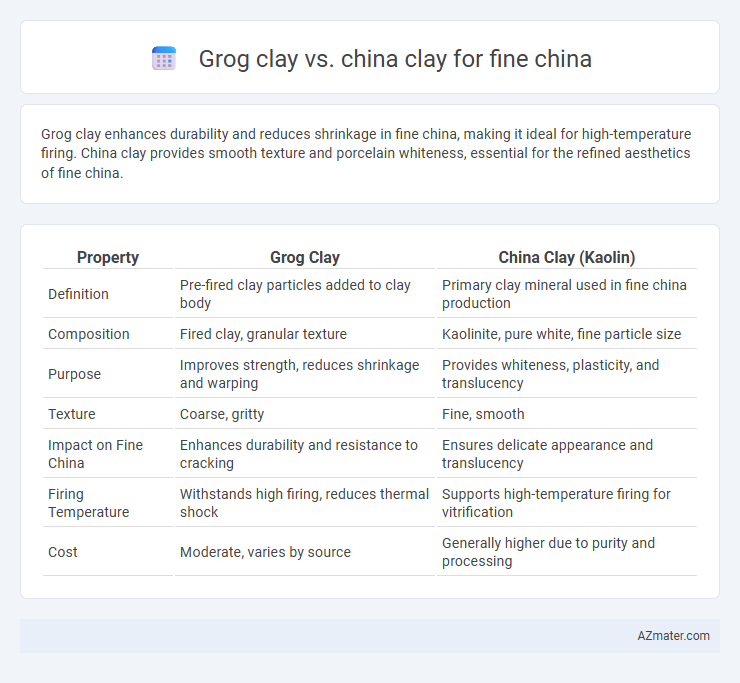Grog clay enhances durability and reduces shrinkage in fine china, making it ideal for high-temperature firing. China clay provides smooth texture and porcelain whiteness, essential for the refined aesthetics of fine china.
Table of Comparison
| Property | Grog Clay | China Clay (Kaolin) |
|---|---|---|
| Definition | Pre-fired clay particles added to clay body | Primary clay mineral used in fine china production |
| Composition | Fired clay, granular texture | Kaolinite, pure white, fine particle size |
| Purpose | Improves strength, reduces shrinkage and warping | Provides whiteness, plasticity, and translucency |
| Texture | Coarse, gritty | Fine, smooth |
| Impact on Fine China | Enhances durability and resistance to cracking | Ensures delicate appearance and translucency |
| Firing Temperature | Withstands high firing, reduces thermal shock | Supports high-temperature firing for vitrification |
| Cost | Moderate, varies by source | Generally higher due to purity and processing |
Introduction to Fine China Materials
Grog clay and China clay are essential materials in the production of fine china, each contributing distinct properties to the final product. Grog clay, composed of pre-fired, crushed ceramic material, enhances strength and thermal shock resistance, while China clay (kaolin) provides plasticity, whiteness, and translucency vital for fine china's delicate appearance. The balanced use of these clays ensures durability, refinement, and aesthetic quality in high-end porcelain craftsmanship.
What is Grog Clay?
Grog clay is a type of clay mixed with pre-fired, ground ceramic particles that enhance strength and reduce shrinkage in fine china production. It improves thermal shock resistance and adds texture to porcelain, making it ideal for delicate, high-quality ceramics. Compared to pure China clay, grog clay offers greater durability and stability during firing processes.
What is China Clay (Kaolin)?
China clay, also known as kaolin, is a fine, white, natural clay primarily composed of the mineral kaolinite. It serves as a crucial raw material in the production of fine china by providing plasticity and whiteness, enhancing the strength and translucency of the finished product. Grog clay differs by containing coarse particles of fired clay that improve thermal shock resistance and reduce shrinkage during firing but lacks the purity and whiteness that kaolin imparts to fine china.
Key Differences Between Grog Clay and China Clay
Grog clay contains pre-fired clay particles that enhance thermal shock resistance and reduce shrinkage, making it ideal for sculptural or heavy-duty ceramic work, whereas China clay, also known as kaolin, is prized for its fine particle size and purity, producing a smooth, white, and translucent finish essential for fine china. The presence of grog in grog clay improves strength and texture but results in a more opaque appearance, while china clay's high alumina content ensures durability combined with delicate aesthetics in porcelain production. Grog clay's coarse structure aids in drying and firing stability, contrasting with the refined, plastic quality of china clay that supports intricate detailing and high-fired vitrification.
Suitability of Grog Clay for Fine China Production
Grog clay enhances fine china production by improving thermal shock resistance and reducing shrinkage during firing, ensuring durability and precision in delicate pieces. Its coarse, crushed firebrick particles create a stable matrix that supports intricate shaping and glazing without deformation. This makes grog clay particularly suitable for fine china, offering significant advantages over the smoother, more plastic China clay in maintaining structural integrity.
Benefits of Using China Clay in Fine China
China clay, also known as kaolin, offers exceptional whiteness and purity critical for producing fine china with a smooth, refined finish. Its fine particle size enhances plasticity, allowing intricate detailing and superior molding precision in porcelain manufacturing. The high alumina and silica content in china clay contribute to improved durability and translucency, making fine china both elegant and long-lasting.
Physical Properties: Grog Clay vs China Clay
Grog clay contains fired clay particles that enhance thermal shock resistance and reduce shrinkage, making it ideal for fine china production requiring durability during firing. China clay, also known as kaolin, is finer and purer with a high alumina content that provides whiteness and translucency but lower thermal resistance compared to grog clay. The combination of grog clay's coarse texture and china clay's smoothness optimizes the physical properties essential for fine china, balancing strength with aesthetic quality.
Firing and Workability Considerations
Grog clay contains pre-fired clay particles that improve thermal shock resistance and reduce shrinkage during firing, making it ideal for fine china that requires durability at high temperatures. China clay, or kaolin, offers a smooth, plastic texture that enhances workability and results in a white, translucent finish but is more prone to warping or cracking without grog inclusion. Balancing grog for structural integrity with china clay for surface refinement is essential in fine china production to achieve both strength and aesthetic quality.
Aesthetic Outcomes: Texture and Finish
Grog clay contains pre-fired clay particles that create a textured surface, enhancing the tactile quality and adding visual depth to fine china pieces. China clay, or kaolin, is finer and produces a smooth, porcelain-like finish, allowing for delicate, translucent aesthetics prized in high-end dinnerware. The choice between grog clay and china clay significantly influences the ceramic's surface texture, with grog imparting rustic character and china clay enabling elegant, refined finishes.
Choosing the Right Clay for Fine China Production
Grog clay contains pre-fired clay particles that improve thermal shock resistance and reduce shrinkage, making it ideal for fine china that requires durability during firing. China clay, or kaolin, is prized for its purity and whiteness, providing the smooth, translucent finish essential to high-quality fine china. Selecting the right clay hinges on balancing grog clay's structural benefits with china clay's aesthetic properties to achieve both strength and elegance in fine china production.

Infographic: Grog clay vs China clay for Fine china
 azmater.com
azmater.com